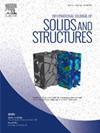用于集群张弦结构柔性多体动态分析的力密度框架
IF 3.4
3区 工程技术
Q1 MECHANICS
International Journal of Solids and Structures
Pub Date : 2024-10-09
DOI:10.1016/j.ijsolstr.2024.113098
引用次数: 0
摘要
本文开发了一种多功能且有效的力密度框架,用于对集束张弦结构进行灵活的多体动力学分析。在这一框架中,力密度被选为基本变量而不是力,聚类张拉整体结构以矢量和矩阵的形式进行数学描述,包括拓扑、几何、材料和力属性。一个非负变量被定义为构件应力状态的指示器,并构建了一个补充函数,以解决电缆单向轴向刚度引起的不连续性问题。在此力密度框架内建立动态公式,选择节点坐标作为通用参数,并以矩阵形式构建公式。作为求解动态方程的替代方法,建立了一个补充框架,将牛顿迭代和电缆状态判断(松弛或拉伸)的孤立步骤转化为统一步骤,为提高求解效率带来了更多潜力。为了验证该方法,我们进行了数值模拟,结果表明该方法能有效揭示集群张弦结构在形状控制过程中的动态振荡、张力变化和拉索松弛行为。对比研究凸显了计算效率的优势。本文提出的方法为研究簇状张弦结构,特别是可部署、主动和智能结构的形状控制提供了一个稳健的数学模型,有助于理解其变形过程中的动态振荡、张力变化和缆索松弛行为。这些方法还可应用于索网结构和其他预应力销钉连接系统。本文章由计算机程序翻译,如有差异,请以英文原文为准。
A force-density framework for flexible multi-body dynamic analysis of clustered tensegrity structures
This paper develops a versatile and effective force-density framework for the flexible multi-body dynamic analysis of clustered tensegrity structures. In this framework, the force density is selected as the basic variable instead of force, and the clustered tensegrity structure is mathematically described in a vector and matrix form, encompassing topology, geometry, material, and force properties. A non-negative variable is defined as an indicator of the member stress state, and a complementary function is constructed to address the discontinuity issues that arise from the unidirectional axial stiffness of cables. Dynamic formulas are established within this force-density framework, with nodal coordinates selected as generalized parameters and formulations constructed in a matrix form. A complementary framework is established as an alternative for solving the dynamic equations, transforming the isolated steps of Newton’s iteration and cable state judgment (slack or tension) into a unified one, bringing more potential for improving solving efficiency. Numerical simulations are carried out to validate the approach, demonstrating that it effectively reveals the dynamic oscillation, tension changes, and cable slack behavior of clustered tensegrity structures during shape control. Comparative studies highlight the advantage of computational efficiency. The method proposed in this paper provides a robust mathematical model for studying clustered tensegrity structures, particularly regarding the shape control of deployable, active, and intelligent structures, aiding in understanding dynamic oscillation, tension changes, and cable slack behavior during their deformation. The methods can also be applied to cable net structures and other prestressed pin-jointed systems.
求助全文
通过发布文献求助,成功后即可免费获取论文全文。
去求助
来源期刊
CiteScore
6.70
自引率
8.30%
发文量
405
审稿时长
70 days
期刊介绍:
The International Journal of Solids and Structures has as its objective the publication and dissemination of original research in Mechanics of Solids and Structures as a field of Applied Science and Engineering. It fosters thus the exchange of ideas among workers in different parts of the world and also among workers who emphasize different aspects of the foundations and applications of the field.
Standing as it does at the cross-roads of Materials Science, Life Sciences, Mathematics, Physics and Engineering Design, the Mechanics of Solids and Structures is experiencing considerable growth as a result of recent technological advances. The Journal, by providing an international medium of communication, is encouraging this growth and is encompassing all aspects of the field from the more classical problems of structural analysis to mechanics of solids continually interacting with other media and including fracture, flow, wave propagation, heat transfer, thermal effects in solids, optimum design methods, model analysis, structural topology and numerical techniques. Interest extends to both inorganic and organic solids and structures.

 求助内容:
求助内容: 应助结果提醒方式:
应助结果提醒方式:


